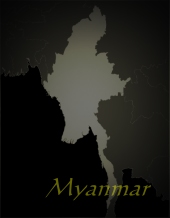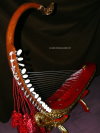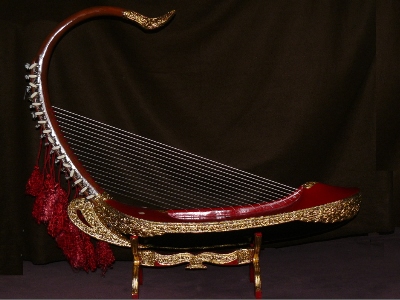
>Home: Map< Instruments Videos Articles Links Biography Contact Disclaimer

| Preface Articles >Instruments< Musicians Books + CDs Links _______________________  |
Instruments
and ensembles
The arched harp "Saung gauk"
Chapter 01: Introduction and History The Myanmar harp saung (or saung gauk) is an arched harp with 14 chords, actually rarely widened to 16 chords. It consists of a hardwood body shaped like a boat, which is covered with deer skin in which three or four resonating holes are cut on a promising astrological occasion. The fourteen (to 16) nylon strings get tuned by pegs or bindings at the acacian neck of the harp. The player sits cross legged on the floor, places the boat shaped body on the right leg with the arch pointing to the right. The right hand plucks the strings with the thumb and index finger while the left hand sometimes changes the pitch of a chord by pressing the thumb against it. The harpist follows the metre provided by the "si" and "wa" of the singer, improvising in the "ti kwe" melodical mode required by the piece performed. This is how it sounds like: * sample (MP3, 1.3 MB) * (played by me, used as backgroundmusic in Kevin Verelst's wonderful video here) Even if the actual shape seems to differ from the pictures in reliefs at Pagan's walls we can assume that the saung is linked to a history of instrumental development which is very old: Analogue models are shown on the walls of Angkor. The existence of harps is manifested in musical history over a long time, first models date back to the year 3000 BC in Mesopotamia. From this first source it might have spread all over Africa and later Asia. There have been several attempts to reconstruct a possible immigration to Burma from India, refering to the Indian "veena" principle (for example Judith Becker), but the true origin of this very ancient instrument is still unknown and may stay speculative in nature. Another interesting but still remaining unresearched fact is the appearance of other arched harps within Myanmars ethnic minorities and other similar instruments like the "mi gyaun" zither of the Karen which is shaped like a crocodile. The harp became a famous instrument in Myanmars chamber music tradition and is not easy to learn. It shares a modal usage of scales with several other instruments in India and Vietnam and knows a rich tradition of songs and tunings, dating back over 800 years. Today only few artists remain who know how to play and tune this outstanding instrument. Chapter 02: How to play and Tunings Allthough the harp is played with only two fingers of the right hand it is not so easy to learn. There are many different techniques and tunings to learn, like we will see below. There are several possibilities to tune the harp. Most of the ancient tunings are not used any more as the younger generation is not used to hear the difference in the quarter tone steps, so all of the four major tunings are arranged as a derivate of diatonic Western scales. Here is an overview of the tunings used today: Tunings The strings of the harp consist of thread or yearn and are easy to be rmade and attached (video). Most of the harps sold today know tuning pegs like on a guitar, but sometimes some models still have the tuning tassels which require a lot of practise to tune a string correctly. Here you can find a video of my teacher showing me how to tune a harp with tassels. Playing the harp also needs a lot of practise and requires a teacher for the best results! The player sits cross legged on the floor, places the boat shaped body on the right leg with the arch pointing in front. The right hand plucks the strings with the thumb and index finger. It is very improtant that the hand stays flat and follows the direction of the strings upwards while playing. Plucking the strings should happen at the spots indicated red in the picture! The left hand sometimes changes the pitch of a chord by pressing the thumb against it. In the first lessons, the student learns: - how to use index finger and thumb (video) - how to use both fingers together (video) - how to use suspension notes (video) - how to introduce suspension notes (video) - how to use the important stop techniques (video) and finally how to play the first easy pieces (see the next chapter) Chapter 03: Videos and scores Here you can find some scores (in PDF format) and videos (Youtube, performed by my teacher U Phone Myint) Some pieces are more easy and suite the beginner while others need lots of practising. I hope you enjoy! 01: "Si Ne War" video 02: "Mya Man Gi Ri" video 03: "Sein Htwe Kyaw Nyung" video 04: "Lu Ma Hnaw" video 05: "The whole midnight" video 06: "Way Bar Ge Ri" video 07: "Taw Hnit Taung Swe" video 08: "Tei Dar - Tei Dar" video 09: "Tha Yar - Tha Yar" video 10: "Thi Dar - Thi Dar" video 11: "Waiza Yandar" video Sheet music for the pieces above can be found here! Pictures (click to enlarge):  

  -> Back to the list of instruments |
